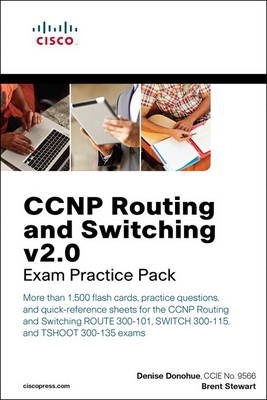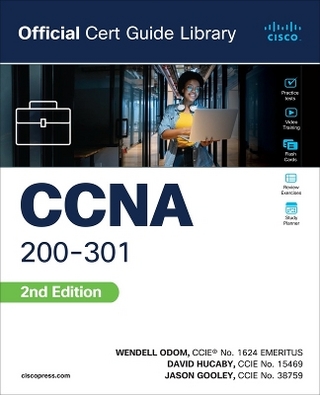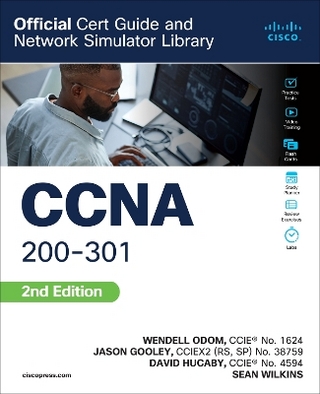
CCNP Routing and Switching v2.0 Exam Practice Pack
Cisco Press
978-1-58714-431-8 (ISBN)
- Keine Verlagsinformationen verfügbar
- Artikel merken
Test Engine
The CCNP practice exam engine includes hundreds of exam-realistic practice exam questions in the powerful Pearson IT Certification Practice test software for each of the three ROUTE, SWITCH, and TSHOOT exams.
Flash Cards
More than 900 flash cards in customizable sets that you can tailor to your study needs. Available in the unique Cert Flash Cards Online application, so you can access from your desktop or favorite mobile devices.
Quick Reference Guides
All exam topics are covered for a quick review and refresh in a comprehensive graphical quick reference guides for each exam.
What's in the package? This product includes a print copy of the quick reference guides for all three CCNP Routing and Switching exams. The CD that accompanies the book provides readers with access to the flash cards in the Pearson IT Certification Cert Flash Cards Online application. User can also install and access the practice tests for all three exams by installing the Pearson IT Certification practice test software on the CD.
Denise Donohue, CCIE No. 9566, is a senior solutions architect with Chesapeake NetCraftsmen. She has worked in IT since the mid-1990s. Focusing on network design since 2004, she has consulted on a wide range of networks, private and public, of all sizes, across most industries. She is author or co-author of numerous Cisco Press networking, voice, and design books. Denise lives in Maryland with her wonderfully patient and supportive husband, Kevin, and their two much less patient dogs. Brent Stewart, CCNP, CCDP, CCSI, MCSE, is the vice president of Managed Services at Stalwart Systems (stalwartsystems.com), an innovative IT engineering firm focused on secure IT architectures. His experience includes designing and managing a large-scale worldwide voice, video, and data network. He was a course director for Global Knowledge and participated in the development of BSCI with Cisco and has written and taught extensively on CCNA and CCNP. Brent lives in Hickory, North Carolina, with his beautiful wife, Karen, and their mischievous children Benjamin, Kaitlyn, Madelyn, and William.
Introduction xx
Part I ROUTE 1
Chapter 1 Networking Overview 3
IP, TCP, and UDP Operations 3
IP Operations 3
TCP Operations 4
UDP Operations 4
Routing Fundamentals 5
The Routing Table 5
Administrative Distance 6
Choosing a Routing Protocol 7
Distance Vector Protocols 7
Link State Protocols 7
Path Vector Protocols 7
Packet Forwarding 8
Configuring and Troubleshooting CEF 9
Loop Prevention Mechanisms 10
Split Horizon 10
Route Poisoning 10
Chapter 2 IPv6 Overview 11
IPv6 Addressing 12
Simplifying an IPv6 Address 12
Special Addresses 13
IPv6 Host Addressing 14
Neighbor Discovery Protocol 14
Manual IP Address Assignment 14
Manual Network Assignment 15
Stateless Address Autoconfiguration 16
Securing NDP 17
DHCPv6 17
Renumbering 17
IPv6 Routing 17
Static Routing 18
IPv6 Route Summarization 18
Integrating IPv4 and IPv6 19
Tunneling IPv6 over IPv4 20
Manual Tunnels 20
GRE Tunnels 20
6to4 Tunnels 21
ISATAP Tunnels 21
IPv6 Link Types 22
Point-to-Point Links 22
Point-to-Multipoint Links 22
Multiaccess Links 23
Chapter 3 RIP 24
RIP Version 2 24
RIPv2 Configuration 25
RIPng for IPv6 25
RIPng Configuration 26
Chapter 4 EIGRP 27
EIGRP Overview 27
EIGRP Neighbor Establishment 28
Packet Types 28
Neighbor Discovery and Route Exchange 28
Unicast Neighbors 29
Troubleshooting and Verifying EIGRP Neighbors 29
EIGRP Route Selection 29
EIGRP Metric 29
Wide Metrics 30
Diffusing Update Algorithm 31
EIGRP for IPv4 32
Basic Configuration 32
Optimizing the EIGRP Configuration 33
Passive Interface 33
Advertising a Default Route 33
Summarization 33
Load Balancing 34
EIGRP Authentication 35
EIGRP Stub Routing 36
EIGRP for IPv6 37
Verifying and Troubleshooting EIGRP 38
EIGRP Named Mode 39
EIGRP Over WAN Links 40
Layer 3 MPLS WAN 40
Layer 2 WAN 41
Frame Relay 41
EIGRP Over the Top 44
Chapter 5 OSPF 45
OSPF Overview 45
OSPF Network Structure 45
OSPF Metric 47
Link-State Advertisements 47
LSA Operation 48
LSA Types 48
OSPF Operation 49
OSPF Packets 49
OSPF Neighbor Relationships 50
Basic OSPFv2 Configuration 51
Router ID 52
Verifying and Troubleshooting OSPF 52
OSPF Network Types 53
Designated Routers 54
Nonbroadcast Multiaccess Networks 55
OSPF over Layer 2 and Layer 3 MPLS 55
Advanced OSPF Configuration 56
OSPF Summarization 56
Passive Interface 57
OSPF Default Routes 57
Stub and Not-So-Stubby Areas 58
Virtual Links 58
OSPF Authentication 59
OSPF for IPv6 61
OSPFv3 LSAs 62
Traditional OSPFv3 Configuration 63
New OSPFv3 Configuration 64
Chapter 6 Advanced Routing Techniques 67
Controlling Routing Updates 67
Route Maps 68
Route Map Syntax 68
Route Map Match and Set Conditions 68
Controlling Route Redistribution Using
Route Maps 69
Tagging Routes Using a Route Map 70
Prefix Lists 71
Distribute Lists 72
Passive Interfaces 73
Using Multiple Routing Protocols 73
Configuring Route Redistribution 73
Seed Metric 74
Administrative Distance 75
Planning Route Redistribution 76
Redistribution Techniques 77
Path Control 78
Policy-Based Routing 79
Using IOS IP SLA 81
VRF-Lite 84
Chapter 7 BGP and Internet Connectivity 88
Planning an Internet Connection 88
Types of ISP Connections 88
IP Addressing and AS Numbering 89
BGP Route Options 89
BGP Overview 90
BGP Databases 91
BGP Message Types 91
BGP Next-Hop Selection 92
BGP Next Hop on a Multiaccess Network 93
BGP Synchronization Rule 93
Configuring Basic BGP 93
BGP Network Command 94
BGP Peering 95
BGP Peering States 95
Troubleshooting BGP 96
BGP Path Selection 96
BGP Attributes 96
BGP Path Selection Criteria 97
Influencing BGP Path Selection 98
Filtering BGP Routes 99
Prefix Lists 99
AS Path Access List 100
Order of Operations 101
BGP Authentication 101
Verifying BGP 102
Multiprotocol BGP 105
Chapter 8 Infrastructure Security 107
Device Access Control 107
Router Security Features 108
Access Control Lists 108
Configuring IPv4 ACLs 109
Configuring an IPv6 Access List 110
Unicast Reverse Path Forwarding 110
Tunneling Technologies 111
GRE Tunnels 112
Configuring a GRE Tunnel 112
DMVPN 113
Easy VPN 113
PPPoE 114
Chapter 9 Infrastructure Services 116
Simple Network Management Protocol 116
SNMPv2c Configuration 117
SNMPv3 Configuration 117
Logging 118
Debug 119
Syslog 119
Configuring Syslog 120
Network Time Protocol 121
DHCP 122
DHCP for IPv4 122
Configuring DHCP for IPv4 122
IPv4 DHCP Relay Agent 123
DHCP for IPv6 123
DHCPv6 Process 124
Configuring Stateful DHCPv6 124
Configuring Stateless DHCPv6 125
IPv6 DHCP Relay Agent 125
NetFlow 126
Network Address Translation 127
Configuring Traditional NAT for IPv4 128
Static NAT 128
Dynamic NAT 129
PAT 129
Configuring NAT Virtual Interface 130
NAT64 131
Part II Switch 133
Chapter 1 LAN Switching Basics 135
MAC Address Operation 135
MAC Address Learning 136
Frame Forwarding 137
Neighbor Discovery Protocols 138
Cisco Discovery Protocol 139
LLDP 141
Switch Traffic Monitoring 144
SPAN 145
RSPAN 146
Chapter 2 VLANs 148
VLAN Overview 148
VLAN Planning 150
Creating a VLAN and Assigning Ports 150
Verifying VLAN Configuration 151
VLAN Trunking 153
Configuring a Trunk Link 154
Pruning VLANs on a Trunk 154
Verifying a Trunk Link 155
Best Practices for Trunking 155
VLAN Trunking Protocol 155
VTP Switch Roles 156
Configuring VTP 157
Verifying and Monitoring VTP 158
Adding a New Switch to a VTP Domain 158
Troubleshooting VLAN Issues 159
Troubleshooting User Connectivity 159
Troubleshooting Trunking 159
Troubleshooting VTP 160
Chapter 3 EtherChannels 161
EtherChannel Overview 161
Configuring an EtherChannel 162
Channel Negotiation Protocols 164
Verifying EtherChannel Configuration 164
EtherChannel Load Balancing 166
EtherChannel Guard 167
MEC and vPC 168
Chapter 4 Spanning Tree Protocol 169
Understanding Basic Spanning Tree Protocol 170
Spanning Tree Election Criteria 171
STP Election 171
Root Bridge Election 172
Root Port Election 173
Designated Port Election 173
Bridge Protocol Data Units 175
Spanning Tree Port States 176
Configuring and Verifying Spanning Tree 176
Per-VLAN Spanning Tree 178
Rapid Spanning Tree 178
RSTP Port Roles 179
BPDU Differences in RSTP 180
RSTP Fast Convergence 181
Multiple Spanning Tree 181
Spanning Tree Improvements 183
PortFast 183
UplinkFast 184
BackboneFast 184
BPDU Guard 184
BPDU Filter 185
Root Guard 185
Unidirectional Link Detection 186
Loop Guard 187
Using Spanning Tree Improvements 187
Troubleshooting STP 189
Spanning-Tree Best Practices 190
Chapter 5 First Hop Redundancy Protocols 191
Hot Standby Router Protocol 193
HSRP States 194
Configuring HSRP 195
HSRP with Tracking 198
HSRP for IPv6 199
Virtual Router Redundancy Protocol 200
Configuring VRRPv2 201
Configuring VRRPv3 203
GLBP 203
GLBP for IPv6 205
Planning Router Redundancy Implementation 205
Chapter 6 InterVLAN Routing 206
InterVLAN Routing Using an External Router 206
InterVLAN Routing Using Multilayer Switches 208
Multilayer Switch Interfaces 209
SVI Configuration 209
Routed Switch Port Configuration 212
The Layer 2 and Layer 3 Forwarding Process 214
Layer 2 Forwarding 214
Layer 3 Forwarding 214
Understanding the Switching Table 215
Understanding Switch Forwarding Architectures 215
CEF Switching 216
Chapter 7 Switch Security Features 219
MAC Address-Based Attacks 219
MAC Address Flooding 219
Port Security 220
Configuring Port Security 221
Error-Disabled Ports 222
Port Access Lists 222
VLAN-Based Attacks 223
Storm Control 223
Switch Spoofing 223
802.1Q Double-Tagging 224
VLAN Access Control Lists 225
Private VLANs 226
Protected Ports 227
Spoof Attacks 227
DHCP Spoofing 227
IP Source Guard 228
ARP Spoofing and DAI 229
Securing Your Switch 229
Using AAA 230
RADIUS 231
TACACS+ 231
Configuring AAA 231
Local Authentication 231
RADIUS Authentication 231
TACACS+ Authentication 232
Configuring Authorization 233
Configuring Accounting 233
Verifying AAA Operation 234
Port-Based Authentication 235
Chapter 8 Campus Network Design 236
The Hierarchical Design Model 236
Core Layer 237
Small Network Design 238
Campus Network Design 238
Network Traffic Flow 239
Planning a Network Implementation 240
Resiliency and High Availability 241
Fast Failover and Convergence 241
Redundancy 242
Layer 2 versus Layer 3 Access Design 243
SSO, NSF, and ISSU 245
Virtual Switching System 246
Using Standalone Access Switches 246
Part III TSHOOT 247
Chapter 1 Tools and Methodologies of Troubleshooting 249
Troubleshooting Methodology 249
Structured Troubleshooting 250
What to Do When Nothing Works! 252
Best Practices for Routine Maintenance 253
Methodology 254
Common Tasks 254
Troubleshooting Tools 257
Configurations 260
Other Tools 264
Working with External Tools 265
Packet Sniffing 265
NetFlow 266
SNMP and EEM 267
Hardware Diagnostics 267
Discovery 270
Self-Documenting Networks 274
Chapter 2 Troubleshooting Switching Technologies 276
Hardware 277
Troubleshooting Scenario 280
VLANs 280
DHCP Troubleshooting Example 281
Spanning Tree Protocol 282
BPDU Guard Example 286
SVIs 286
Troubleshoot SVIs 286
Trunking and EtherChannel 287
Port Security 288
Chapter 3 Troubleshooting IP Networking 290
IP Address Assignment 290
NTP, Syslog, and SNMP 292
NTP 293
Syslog 294
SNMP 294
Gateway Redundancy 295
Filtering 297
NAT 299
Steps to Troubleshooting NAT 299
Rule Out NAT 300
Understand the Objective of NAT 300
Verify the Translation 301
Verify the Translation Is Being Used 301
Authentication 302
Chapter 4 Troubleshooting Routing Technologies 303
Network Layer Connectivity 303
Routing Protocols 304
Router Performance 304
EIGRP 307
Is the Correct Route Advertised? 307
Is the Correct Route Communicated? 308
Is There a More Desirable Path? 309
OSPF 309
Is the Correct Route Advertised? 310
Is the Correct Route Communicated? 310
Is There a More Desirable Path? 311
BGP 311
Is the Correct Route Advertised? 311
Is the Correct Route Communicated? 311
Is There a More Desirable Path? 312
Route Redistribution 313
9781587144318 TOC 10/24/2014
| Erscheint lt. Verlag | 7.12.2014 |
|---|---|
| Verlagsort | Indianapolis |
| Sprache | englisch |
| Maße | 155 x 230 mm |
| Gewicht | 533 g |
| Themenwelt | Mathematik / Informatik ► Informatik ► Netzwerke |
| Informatik ► Weitere Themen ► Zertifizierung | |
| ISBN-10 | 1-58714-431-X / 158714431X |
| ISBN-13 | 978-1-58714-431-8 / 9781587144318 |
| Zustand | Neuware |
| Haben Sie eine Frage zum Produkt? |
aus dem Bereich


